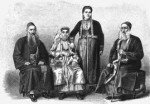
From the Jewish Telegraphic Agency, October 24, 2004 You may not find Dr. Neil Rosenstein’s new book listed on national best-seller lists, but the noted genealogist — with his tongue halfway in his cheek — compares it to the popular thriller “The Da Vinci Code.” Both books, the noted American genealogist and surgeon said, deal in…









